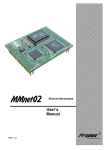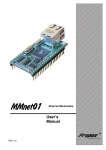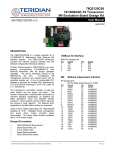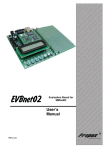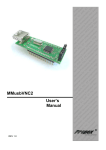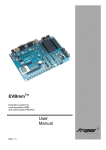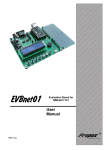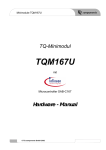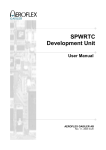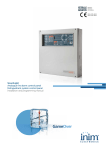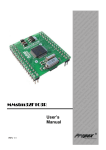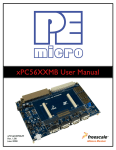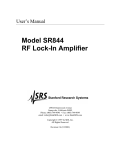Download User`s Manual
Transcript
Ethernet Minimodule User’s Manual REV 0.9 , lu ard ST Sta rve a , e o Ev B VR ers b S l d n io 1, A trol We mo t a ‘5 n d ni ri o e r c fo cro dd s M the e s d e i m mb oar rs, peC E B e S PI its ng roll gh r K pi nt Hi fo r y o rte tot roc FID ers s o c r Pr mi s, R mm lle rs or ler gra tro f ol n o s pr oco CB e ntr l u o m icr s, P for c e t t m m ds s ne Sy T te ar s S l n I , sy Bo tro C d e PI or ion on b , es at roc We R c u AV pro val mic ed iro E dd ic ng PIC be ds m M ni T, m r g S E oa rs, i s , ts e B de VR Ki ng roll t h A ter pi n g i , y o t 1 r H ‘5 Sta oto roc ID c r e rs P mi RF m e s l , r er fo ers ram trlv g n r s ll Se ule tro pro oco od con ms icr s, m ni net ste T m stem er Sy , S sy Bo h et d In PIC sor on e , ce ati ic e R m o u Sp AV opr val IC e r r fo ic g E T, P mb rs s M nin , S E g s r t g R i i in le ol des , AV er K typ B `51 tart roto roS s P mic , PC for s s ller er for llers d ar tro erw les tro on b S du con ram c ro We imo et rog o n p n ed Mi her m roc d d ds et ste ic ar rs, Sy T m r o B olle In , S so tr ed IC oce ign P s co Spe R, opr De V cr h B Rtion ig r A Mi C a H f o rs , Pone asolution lu Many ideas s e s l v s m er ol m ntr ste g E ard co Sy nin Bo Contents 1 INTRODUCTION ....................................................................................................................................... 3 APPLICATIONS .............................................................................................................................................. 4 FEATURES .................................................................................................................................................... 4 CONSTRUCTION OF THE MODULE ............................................................................................... 5 2 BLOCK DIAGRAM .......................................................................................................................................... 5 MODULE PIN-OUT ......................................................................................................................................... 6 ATMEGA128 MICROCONTROLLER ............................................................................................................. 13 ETHERNET CONTROLLER LAN91C111..................................................................................................... 13 MEMORY CONTROLLER .............................................................................................................................. 14 RAM MEMORY ........................................................................................................................................... 19 DATAFLASH MEMORY................................................................................................................................. 19 REAL-TIME CLOCK ...................................................................................................................................... 20 SUPPLY OF POWER .................................................................................................................................... 20 RESET CIRCUIT ........................................................................................................................................ 20 LED DIODES ............................................................................................................................................... 21 CONNECTION OF THE MODULE WITH THE EXTERNAL WORLD ....................................... 22 3 CONNECTION TO THE ETHERNET NETWORK ............................................................................................. 22 USB INTERFACE ........................................................................................................................................ 22 RS-232 INTERFACE ................................................................................................................................... 23 RS-485 INTERFACE ................................................................................................................................... 23 RADIO LINK ................................................................................................................................................. 24 LCD DISPLAY ............................................................................................................................................. 24 EXTERNAL PERIPHERALS ON THE SYSTEM BUS ......................................................................................... 25 PROGRAMMING THE MODULE..................................................................................................... 27 4 ISP CONNECTOR ........................................................................................................................................ 27 JTAG CONNECTOR .................................................................................................................................... 29 5 AN APPLICATION EXAMPLE ......................................................................................................... 30 6 EVALUATION BOARD...................................................................................................................... 31 7 SPECIFICATIONS.............................................................................................................................. 31 8 TECHNICAL ASSISTANCE ............................................................................................................. 32 9 GUARANTEE ...................................................................................................................................... 32 10 ASSEMBLY DRAWINGS.............................................................................................................. 32 11 DIMENSIONS .................................................................................................................................. 34 12 SCHEMATICS ................................................................................................................................. 34 1 Introduction Thank you very much for having bought our minimodule MMnet104. It was created with the idea of facilitating the communication of microprocessor systems through the Internet/Ethernet networks. The heart of the module is the RISC Atmega128 microcontroller with 128kB of program memory and 128kB of (external) RAM memory, co-operating with the Ethernet RTL8018AS controller (100BaseTX). The memory controller built around a programmable CPLD device manages the address space of the microcontroller, generates address strobe/selection signals used during extension of the server by external I/O units, and serves the banking of RAM memory. The minimodule has an 8 MB DataFlash serial memory for storage of WWW pages and of any files e.g. with measurement data. The memory is connected to a fast SPI bus with 8 Mb/s transmission speed. The MMnet104 has been equipped with a RTC clock built around the DS1307 device, connected to the I2C bus. Together with the RTC circuit goes a socket for a lithium battery providing many guaranteed years of uninterrupted clock operation. MMnet104 operates under real-time control RTOS allowing to build applications with the use of pseudo-concurrency in which different tasks are started and executed in the form of separate threads. This permits an easy construction of applications which require parallel execution of several tasks, for example servicing the TCP/IP stack and realizing the algorithm of control of an industrial process. The RTOS system has an extended interface for handling peripheral equipment, thanks to which the communication with them occurs via drivers registered in the system. The system has drivers for the Ethernet controller, serial ports, the 1-Wire bus, the DS 1820 thermometer, LCD display RTC clock and DataFlash memory. The kernel of the RTOS system and the TCP/IP stack together with implemented DHCP, UDP, ICMP, SMTP protocols and HTTP with simple CGI-s were compiled to libraries. The system incorporates a series of demonstration applications (WWW server, FTP, Telnet, TCP client, TCP server, temperature monitoring and control, applications in the RTOS system) which are basing on completed functions present in the IP stack and RTOS operating system libraries. Attached libraries permit independent experiments (e.g. creation of web pages using the CGI technique without penetrating the lower layers of the IP stack and the RTOS operating system). The MMnet104 is delivered loaded with the WWW Server application and WWW demonstration pages with examples of using CGI and Flash. The configuration of the server (MAC address, IP, gateway, change of WWW page) can be effected remotely through serial RS232 or FTP ports. Sources in C-language and ready libraries are attached to the server; they can be used to realize one’s own projects. To modify and compile, the free C-compile GCC or C-compiler from ImageCraft can be put into use. We wish you nothing but success and a lot of satisfaction in designing and developing new electronic equipment based on the MMnet104 minimodule. 3 Applications The MMnet104 minimodule can be used as a design base for electronic circuits co-operating from the Ethernet/Internet network, covering the following areas of interest: • • • • • • • • • • • Industrial remote controlling and monitoring systems Telemetry Intelligent buildings Alarm systems Weather stations and environment monitoring Medical electronics Heating and air-conditioning systems Telecommunication Road traffic monitoring Remote data logging Home automation The MMnet104 minimodule can be also used in didactic workshops of information and electronic schools, illustrating the aspects of co-operation of electronic circuits from the Ethernet/Internet network, as well as be used to construct thesis circuits. Features • • • • • • • • • • • • • • • • • • • Fast RISC microcontroller ATmega128 with up to 16 MIPS throughput Ethernet controller IEEE 802.3 10/100Mb/s Onboard RJ45 connector with integrated magnetics and LED diodes Onboard USB interface (device) with USB-B connector 128kB of in circuit programmable FLASH program memory 128KB of RAM memory 4kB of EEPROM memory (1) Serial DataFlash memory 32 or 64Mbit (4 or 8MBytes) Flexible memory controller, allowing suit address space to application requirements (1) I2C Real Time Clock and battery socket Reliable reset circuit Crystal resonator 14.7456 or 16 MHz Crystal resonators 32.768 Hz for RTC and MCU internal timer/counter 4 LED diodes indicating: power, LAN activity, DataFlash activity Fully SMD made on 4-layer PCB 2 x 32 terminals with 0.1" (2.54mm) pitch fitting every prototype board Available free operating system with TCP/IP stack supporting many protocols Available evaluation board and sample applications Small dimensions: 56mm x 59mm Remarks: 1. Assembled in dependence on the MMnet104 version 4 2 Construction of the module Block diagram The block diagram of the MMnet104 minimodule is shown in the drawing: BUS memory controller PORTE USB 128kB RAM ATmega128 LAN91C111 PORTF EEPROM PORTB PORTD RTC 16MHz DataFlash 1 DataFlash 2 32kHz 32kHz Batt GND Figure 1 Block diagram of the MMnet104 minimodule. The minimodule is sold in three basic versions, denoted with letters from A to C, or in accordance with individual orders. Module MMnet104- A contains: • ATmega128 microcontroller • Ethernet controller LAN91C111 • 128kB RAM Module MMnet104- B contains: • ATmega128 microcontroller • Ethernet controller LAN91C111 • 128kB RAM • One DataFlash 32Mb (4MB) memory • Real Time Clock with socket for lithium battery Module MMnet104- C contains: • ATmega128 microcontroller • Ethernet controller LAN91C111 • 128kB RAM • Two DataFlash memories with 64Mb (8MB) of total capacity • Real Time Clock with socket for lithium battery 5 Individual orders coding: MMnet104 – r – b – f – x – e 0 – without RTC 1 - RTC DS1307 0 - without DataFlash memory 1 - 32Mb DataFlash 2 - 2x32Mb DataFlash 0 – without battery socket 1 - with CR2023 battery socket 3.6864 4 6 8 11.059 14.7456 16 0 - without LAN91C111 1 - with LAN91C111 - Crystal 3.6864 MHz - Crystal 4 MHz - Crystal 6 MHz - Crystal 8 MHz - Crystal 11.059 MHz - Crystal 14.7456 MHz - Crystal 16 MHz Module pin-out Figure 2 Module pin-out – top view. 6 Function in MMnet104 Interrupt from LAN91C111 (optionally) Interrupt from LAN91C111 USB – TxD Function in MMnet104 RTC – SDA DataFlash1 – #CS DataFlash1/2 – MISO DataFlash1/2 – SCK J1 Name Name AD7 1 2 AD6 AD5 3 4 AD4 AD3 5 6 AD2 AD1 7 8 AD0 A1 9 10 A0 SEL2 11 12 SEL1 PE7/ INT7 13 14 PE6/ INT6 PE5/ INT5 15 16 PE4/ INT4 PE3/ AC- 17 18 PE2/ AC+ PE1/ PDO/TxD 19 20 PE0/ PDI/RxD PF7/ ADC7/TDI 21 22 PF6/ ADC6/TDO PF5/ ADC5/TMS 23 24 PF4/ ADC4/TCK PF3/ADC3 25 26 PF2/ ADC2 PF1/ ADC1 27 28 PF0/ ADC0 AREF 29 30 AGND A+5V 31 32 AGND J2 Name Name Function in MMnet104 USB – RxD Function in MMnet104 +5V 1 2 GND +3.3V 3 4 GND Vbat 5 6 GND NC 7 8 NC NC 9 10 NC LEDLINK 11 12 LEDACT #RESET 13 14 LEDDF #WR 15 16 #RD PD7/T2 17 18 PD6/ T1 PD5 19 20 PD4/ IC1 PD3/#INT3/TxD1 21 22 PD2/#INT2/RxD1 PD1/#INT1/SDA 23 24 PD0/#INT0/SCL RTC – SCL PB7/ OC2/PWM2 25 26 PB6/OC1B/PWM1B DataFlash2 - #CS PB5/ OC1A/PWM1A 27 28 PB4/OC0/PWM0 PB3/ MISO 29 30 PB2/MOSI PB1/ SCK 31 32 PB0/#SS DataFlash1/2 - MOSI 7 No. 1 2 3 4 5 6 7 8 9 Function AD7 AD6 AD5 AD4 AD3 AD2 AD1 AD0 A1 Alt. function 10 A0 11 12 SEL2 SEL1 13 PE7 INT7 14 PE6 INT6 15 PE5 INT5 16 PE4 INT4 17 PE3 AC- 18 PE2 AC+ J1 Description Data bus. Allows connecting externals peripherals mapped in microcontroller address space. Peripheral addressing is done with use of SEL1, SEL2 and/or A0, A1, #WR, #RD outputs. Lowest two bits of address bus. Allows addressing 4 input and 4 output registers. Note: outputs operate in 3.3V logic level standard. Read/write strobe or address decoder outputs. Note: outputs operate in 3.3V logic level standard. PE7 – General purpose digital I/O Alternative functions: INT7 – External Interrupt source 7: The PE7 pin can serve as an external interrupt source. IC3 – Input Capture Pin3: The PE7 pin can act as an input capture pin for Timer/Counter3. PE6 – general purpose digital I/O Alternative functions: INT6 – External Interrupt source 6: The PE6 pin can serve as an external interrupt source. T3 – Timer/Counter3 counter source. PE5 – general purpose digital I/O Alternative functions: INT5 – External Interrupt source 5: The PE5 pin can serve as an External Interrupt source. OC3C – Output Compare Match C output: The PE5 pin can serve as an External output for the Timer/Counter3 Output Compare C. The pin has to be configured as an output (DDE5 set “one”) to serve this function. The OC3C pin is also the output pin for the PWM mode timer function. PE4 – general purpose digital I/O Alternative functions: INT4 – External Interrupt source 4: The PE4 pin can serve as an External Interrupt source. OC3B – Output Compare Match B output: The PE4 pin can serve as an External output for the Timer/Counter3 Output Compare B. The pin has to be configured as an output (DDE4 set (one)) to serve this function. The OC3B pin is also the output pin for the PWM mode timer function. PE3 – general purpose digital I/O Alternative functions: AC- – Analog Comparator Negative input. This pin is directly connected to the negative input of the Analog Comparator. OC3A, Output Compare Match A output: The PE3 pin can serve as an External output for the Timer/Counter3 Output Compare A. The pin has to be configured as an output (DDE3 set “one”) to serve this function. The OC3A pin is also the output pin for the PWM mode timer function. PE2 – general purpose digital I/O Alternative functions: AC+ – Analog Comparator Positive input. This pin is directly connected to the positive input of the Analog Comparator. XCK0, USART0 External clock. The Data Direction Register (DDE2) controls whether the clock is output (DDE2 set) or input (DDE2 cleared). The XCK0 pin is active only when the USART0 operates in Synchronous mode. 8 19 PE1 PDO/TxD 20 PE0 PDI/RxD 21 PF7 ADC7 22 PF6 ADC6 23 PF5 ADC5 24 PF4 ADC4 25 PF3 ADC3 26 PF2 ADC2 27 PF1 ADC1 28 PF0 ADC0 29 30 AREF AGND 31 A+5V 32 AGND PE1 – general purpose digital I/O Alternative functions: PDO – SPI Serial Programming Data Output. During Serial Program Downloading, this pin is used as data output line for the ATmega128. TXD0 – UART0 Transmit pin. PE0 – general purpose digital I/O Alternative functions: PDI – SPI Serial Programming Data Input. During Serial Program Downloading, this pin is used as data input line for the ATmega128. RXD0 – USART0 Receive Pin. Receive Data (Data input pin for the USART0). When the USART0 receiver is enabled this pin is configured as an input regardless of the value of DDRE0. When the USART0 forces this pin to be an input, a logical one in PORTE0 will turn on the internal pull-up. PF7 – general purpose digital I/O Alternative functions: ADC7 – Analog to Digital Converter, Channel 7. TDI – JTAG Test Data In: Serial input data to be shifted in to the Instruction Register or Data Register (scan chains). When the JTAG interface is enabled, this pin can not be used as an I/O pin. PF6 – general purpose digital I/O Alternative functions: ADC6 – Analog to Digital Converter, Channel 6. TDO – JTAG Test Data Out: Serial output data from Instruction Register or Data Register. When the JTAG interface is enabled, this pin can not be used as an I/O pin. The TDO pin is tri-stated unless TAP states that shift out data are entered. PF5 – general purpose digital I/O Alternative functions: ADC5 – Analog to Digital Converter, Channel 5. TMS – JTAG Test Mode Select: This pin is used for navigating through the TAP-controller state machine. When the JTAG interface is enabled, this pin can not be used as an I/O pin. PF4 – general purpose digital I/O Alternative functions: ADC4 – Analog to Digital Converter, Channel 4. TCK – JTAG Test Clock: JTAG operation is synchronous to TCK. When the JTAG interface is enabled, this pin can not be used as an I/O pin. PF3 – general purpose digital I/O Alternative functions: ADC3 – Analog to Digital Converter, Channel 3. PF2 – general purpose digital I/O Alternative functions: ADC2 – Analog to Digital Converter, Channel 2. PF1 – general purpose digital I/O Alternative functions: ADC1 – Analog to Digital Converter, Channel 1. PF0 – general purpose digital I/O Alternative functions: ADC0 – Analog to Digital Converter, Channel 0. Analog reference voltage for the A/D converter Analog ground (internally connected with digital ground GND) +5V power supply for analog circuits. Connected internally with +5V through LP filter. External analog circuits can use this voltage. Analog ground (internally connected with digital ground GND) J2 9 No. 1 2 Function +5V GND Alt. function 3 +3.3V 4 GND 5 Vbat 6 7 8 9 10 GND NC NC NC NC 11 LEDLINK 12 LEDACT 13 #RESET 14 LEDDF 15 16 #WR #RD 17 PD7 T2 18 PD6 T1 19 PD5 20 PD4 IC1 21 PD3 #INT3/TxD1 22 PD2 #INT2/RxD1 Description Power supply input +5V Ground Output of +3.3V voltage from internal regulator. Can be used to power external peripherals, which requires +3.3V. Ground Battery voltage sustaining the operation of the RTC clock. If a battery is mounted on the module, this lead-out can be used as a source of power for peripherals external to the module. If there is no battery on the module, the TC clock can be supplied from an external battery or another emergency power source. Ground Not connected. Not connected. The output of the LEDLINK diode driving signal (indicating connection to the Ethernet network). It can be used to connect an additional diode, e.g. led out externally to the device case. The output of the LEDACT diode driving signal (indicating activity of the module in Ethernet network). It can be used to connect an additional diode, e.g. led out externally to the device case. Input/output of RESET signal The output of the LEDDF diode driving signal (indicating activity of the DataFlash memory). It can be used to connect an additional diode, e.g. led out externally to the device case. Write strobe. Read strobe. PD7 – general purpose digital I/O Alternative functions: T2 – Timer/Counter2 counter source. PD6 – general purpose digital I/O Alternative functions: T1 – Timer/Counter1 counter source. PD5 – general purpose digital I/O PD4 – general purpose digital I/O Alternative functions: XCK1 – USART1 External clock. The Data Direction Register (DDD4) controls whether the clock is output (DDD4 set) or input (DDD4 cleared). The XCK1 pin is active only when the USART1 operates in Synchronous mode. IC1 – Input Capture Pin1: The PD4 pin can act as an input capture pin for Timer/Counter1. PD3 – general purpose digital I/O Alternative functions: INT3 – External Interrupt source 3: The PD3 pin can serve as an external interrupt source to the MCU. TXD1 – Transmit Data (Data output pin for the USART1). When the USART1 Transmitter is enabled, this pin is configured as an output regardless of the value of DDD3. PD2 – general purpose digital I/O Alternative functions: INT2 – External Interrupt source 2. The PD2 pin can serve as an External Interrupt source to the MCU. RXD1 – Receive Data (Data input pin for the USART1). When the USART1 receiver is enabled this pin is configured as an input regardless of the value of DDD2. When the USART forces this pin to be an input, the pull-up can still be controlled by the PORTD2 bit. 10 23 PD1 #INT1/SDA 24 PD0 #INT0/SCL 25 PB7 OC2/PWM2 26 PB6 OC1B/PWM1B 27 PB5 OC1A/PWM1A 28 PB4 OC0/PWM0 29 PB3 MISO PD1 – general purpose digital I/O Alternative functions: INT1 – External Interrupt source 1. The PD1 pin can serve as an external interrupt source to the MCU. SDA – Two-wire Serial Interface Data: When the TWEN bit in TWCR is set (one) to enable the Two-wire Serial Interface, pin PD1 is disconnected from the port and becomes the Serial Data I/O pin for the Two-wire Serial Interface. In this mode, there is a spike filter on the pin to suppress spikes shorter than 50 ns on the input signal, and the pin is driven by an open drain driver with slew-rate limitation. PD0 – general purpose digital I/O Alternative functions: INT0 – External Interrupt source 0. The PD0 pin can serve as an external interrupt source to the MCU. SCL – Two-wire Serial Interface Clock: When the TWEN bit in TWCR is set (one) to enable the Two-wire Serial Interface, pin PD0 is disconnected from the port and becomes the Serial Clock I/O pin for the Two-wire Serial Interface. In this mode, there is a spike filter on the pin to suppress spikes shorter than 50 ns on the input signal, and the pin is driven by an open drain driver with slew-rate limitation. PB7 – general purpose digital I/O Alternative functions: OC2 – Output Compare Match output: The PB7 pin can serve as an external output for the Timer/Counter2 Output Compare. The pin has to be configured as an output (DDB7 set “one”) to serve this function. The OC2 pin is also the output pin for the PWM mode timer function. OC1C – Output Compare Match C output: The PB7 pin can serve as an external output for the Timer/Counter1 Output Compare C. The pin has to be configured as an output (DDB7 set (one)) to serve this function. The OC1C pin is also the output pin for the PWM mode timer function. PB6 – general purpose digital I/O Alternative functions: OC1B – Output Compare Match B output: The PB6 pin can serve as an external output for the Timer/Counter1 Output Compare B. The pin has to be configured as an output (DDB6 set (one)) to serve this function. The OC1B pin is also the output pin for the PWM mode timer function. PB5 – general purpose digital I/O Alternative functions: OC1A – Output Compare Match A output: The PB5 pin can serve as an external output for the Timer/Counter1 Output Compare A. The pin has to be configured as an output (DDB5 set (one)) to serve this function. The OC1A pin is also the output pin for the PWM mode timer function. PB4 – general purpose digital I/O Alternative functions: OC0 – Output Compare Match output: The PB4 pin can serve as an eternal output for the Timer/Counter0 Output Compare. The pin has to be configured as an output (DDB4 set (one)) to serve this function. The OC0 pin is also the output pin for the PWM mode timer function. PB3 – general purpose digital I/O Alternative functions: MISO – Master Data input, Slave Data output pin for SPI channel. When the SPI is enabled as a master, this pin is configured as an input regardless of the setting of DDB3. When the SPI is enabled as a slave, the data direction of this pin is controlled by DDB3. When the pin is forced to be an input, the pull-up can still be controlled by the PORTB3 bit. 11 30 PB2 MOSI 31 PB1 SCK 32 PB0 #SS PB2 – general purpose digital I/O Alternative functions: MOSI – SPI Master Data output, Slave Data input for SPI channel. When the SPI is enabled as a slave, this pin is configured as an input regardless of the setting of DDB2. When the SPI is enabled as a master, the data direction of this pin is controlled by DDB2. When the pin is forced to be an input, the pull-up can still be controlled by the PORTB2 bit. PB1 – general purpose digital I/O Alternative functions: SCK – Master Clock output, Slave Clock input pin for SPI channel. When the SPI is enabled as a slave, this pin is configured as an input regardless of the setting of DDB1. When the SPI is enabled as a master, the data direction of this pin is controlled by DDB1. When the pin is forced to be an input, the pull-up can still be controlled by the PORTB1 bit. PB0 – general purpose digital I/O Alternative functions: SS – Slave Port Select input. When the SPI is enabled as a slave, this pin is configured as an input regardless of the setting of DDB0. As a slave, the SPI is activated when this pin is driven low. When the SPI is enabled as a master, the data direction of this pin is controlled by DDB0. When the pin is forced to be an input, the pull-up can still be controlled by the PORTB0 bit. Table 31 and Table 32 relate the alternate functions of Port B to the overriding signals shown in Figure 33 on page 67. SPI MSTR INPUT and SPI SLAVE OUTPUT constitute the MISO signal, while MOSI is divided into SPI MSTR OUTPUT and SPI SLAVE INPUT. Detailed description of PB, PD, PE ports can be found in ATmega128 microcontroller datasheets. 12 ATmega128 microcontroller • • • • • • • • • • • • • • • • • High-performance RISC architecture, 121 instructions (most single clock cycle execution), 16 MIPS at 16MHz 128 KBytes of Flash memory 4K Bytes of SRAM memory 4K Bytes of EEPROM SPI Master/Slave interface Four internal timers/counters 8/16bit Two UART interfaces (up to 1Mbaud) Serial interface compatible with I2C In System Programming In Circuit Debugging through JTAG interface Real Time Clock with 32 kHz oscillator 8 channel 10-bti A/D converter 6 I/O ports 6 PWM outputs Extended temperature range, internal and external interrupt sources Internal watchdog timer More informations at Atmel' s site Ethernet controller LAN91C111 • • • • • • One-chip Ethernet controller with IEEE 802.3 10/100Mb/s Internal 8kB SRAM memory for buffers Built-in data prefetch function to improve performance Full duplex/half duplex Support diagnostic LEDs The module is adapted to operate with the network controller with the use of interrupts. The interrupt signal is applied to input INT5 (PE5) of the microcontroller. The state of the Ethernet controller is signaled by two LED diodes: LNK – connection with the network, and ACT – active (transmission/reception). The location of the controller in the address space is dependent upon the chosen operating mode of the memory controller. 13 Memory controller The memory controller, built around the CPLD programmable device, controls the address space of the microcontroller, generates address strobe/selection signals to be exploited by the user and serves in banking of the RAM memory. The memory controller can operate in three modes which differ in the placement of areas in the address space: • • • Mode of conformity with the EVBedu.net and Ethernet 1 boards – only 32kB of RAM memory is available, situated in the range to 0x7FFF. The registers of the LAN91C111 circuit are under the addresses: 0x8000 – 0x9000. The rest of the RAM memory is not accessible. Memory banking mode. In order to exploit fully the whole memory, the address decoder facilitates the division of the memory into banks of 16kB each. In the range until 0x7FFF the basic unbanked memory is located. Under the addresses 0x8000 – 0xBFFF is the currently used memory bank. The choice of a bank is effected by writing its number to the bank register which is located under the address 0xFF00. In the location up to 0x7FFF (basic memory) always the last bank is visible. Such a solution is always favorable when programming is done in C language, as environment variables and buffers, often used in the program, can be held in the basic memory, while the space with the variable bank number can be used e.g. to collect measurement data, large tables or buffers, the access to which is not hampered by a change in bank number. The Ethernet controller is under the address 0xC000. Maximum linear memory mode – the Ethernet controller is at the end of the address space under the address 0xFF80. The linear memory reaches the address 0xFEFF. This mode permits the achievement of a large linearly addressed memory of the size of 65280B. The memory controller allows also the generation of two signals: SEL1 and SEL2. These signals can be configured as write/read strobe lines or address choice with any polarization. The configuration is achieved by means of appropriate registers. The address space of the microcontroller under the addresses 0xFF00 to 0xFFFF contains an area reserved for MMnet104. It has two registers: a configuration and bank select registers, an area for the peripherals controlled by the SEL outputs and an area for the Ethernet controller. This is depicted in the picture below: … FF80 – FF9F LAN91C111 Ethernet ctrl registers … FF08 – FF0B MMnet104_SEL2 External I/O FF04 – FF07 MMnet104_SEL1 External I/O … FF01 MMnet104_CONF FF00 MMnet104_BANKSR Configuration register Bank select register 14 The MMnet104_BANKSR register contained under the address 0xFF00 is used for the choice of an active RAM memory bank. The contents of this register have a meaning only when mode 1 of the memory controller is chosen. The register has only four lowest bits, during readout the remaining bits (4 – 7) have the value „0” and the value written into them has no meaning. MMnet104_BANKSR 0xFF00 - - - - BANKSR3 BANKSR2 BANKSR1 BANKSR0 7 6 5 4 3 2 1 0 R/W R/W R/W R/W R/W R/W R/W R/W Under the address 0xFF01 is the configuration register of the memory controller. Through this register the operating mode of the controller and the SEL output can be chosen. Configuration should be set after every system reset. MMnet104_CONF 0xFF01 SEL2POL SEL2CFG1 SEL2CFG0 SEL1POL SEL1CFG1 SEL1CFG0 MODE1 MODE0 7 6 5 4 3 2 1 0 W W W W W W W W The meaning of individual bits in the MMnet104_CONF register is shown by the table below: No. Name 7 SEL2POL 6 5 SEL2CFG1 SEL2CFG0 4 SEL1POL 3 2 1 0 SEL1CFG1 SEL1CFG0 MODE1 MODE0 Description SEL2 output polarization. „0” – active low level Operating mode of SEL2 output SEL1 output polarization. „0” – active low level Operating mode of SEL1 output. Operating mode of the address decoder. This register is assigned only for writing. An attempt of readout will return only random values. Two lowest bits of the MMnet104_CONF register, assigned as MODE1 and MODE2, serve to set the operating mode of the address decoder: Mode MODE1..0 0 00 1 01 2 10 Description Conformity mode with earlier equipment and software versions. Available is only 32kB of RAM memory located in the lower area of the address space, and the Ethernet controller under the addresses 0x80000x9000. Memory banking mode. 32kB of non-banking memory is available; the remaining memory is accessible in banks of 16kB each. The Ethernet controller is under the address 0xC000. Mode of maximum linear memory. In this mode the user has at his disposal 65280 memory bites without the need to serve banking. The LAN91C111 controller is under the address 0xFF80. 15 3 11 In this mode the external RAM memory and the Ethernet controller are not accessible. SEL outputs operate normally. Memory maps for modes 1..3 are shown in the picture below: FFFF FF00 FEFF FFFF FF00 FEFF MMnet104 C01F C01E Not used 9000 8FFF 8000 7FFF C000 BFFF LAN91C111 8000 7FFF Non banked RAM and int. RAM of the uC 32kB 0000 MMnet104 Not used FF00 FEFF MMnet104 LAN91C111 Banked RAM 16kB Non banked RAM and int. RAM of the uC 65280B Non banked RAM and int. RAM of the uC 32kB 0000 Mode 0 FFFF 0000 Mode 1 Mode 2 The remaining bits of the configuration register serve to set the operating mode of the SEL outputs and their polarization. Mode SEL1CFG1..0 0 00 1 01 2 10 3 11 Description Write strobe. A pulse is generated at the moment of writing under the address 0xFF04 – 0xFF07. Polarization of the pulse is set by the SEL1POL bit. Read strobe. A pulse is generated at the moment of reading under the address 0xFF04 – 0xFF07. Polarization of the pulse is set by the SEL1POL bit. Address decoder. A pulse is generated at the moment of writing or reading from the address 0xFF04-0xFF07. Polarization of the pulse is set by the SEL1POL bit. Additional output. Signal SEL1 assumes the value of the SEL1POL bit. 16 Mode SEL2CFG1..0 Description 0 00 Write strobe. A pulse is generated at the moment of writing under the address 0xFF08 – 0xFF0B. Pulse polarization is set by the SEL2POL bit. 1 01 Read strobe. A pulse is generated at the moment of reading under the address 0xFF08 – 0xFF0B. Pulse polarization is set by the SEL2POL bit. 2 10 3 11 Address decoder. A pulse is generated at the moment of writing or reading under the address 0xFF08 – 0xFF0B. Pulse polarization is set by the SEL2POL bit. If the module is fitted with a 256kB of RAM memory, output SEL2 is used as the highest bit of the address bus (in this case it must operate in mode 3) and cannot be used outside the module. If the module is fitted with a 128kB of RAM memory, output SEL2 in mode 3 can be used as additional output. It takes then the state of bit 3 in the MMnet104_BANKSR register. The drawings below illustrate the operation of output SEL during writing or reading operation. ADDR x 0xFF04-0xFF07 - SEL1 0xFF08-0xFF0B - SEL2 x #WR #RD SELx Figure 3 Operation of SEL output as write strobe (SELxCFG1..0=00) with active low level (SELxPOL = 0). ADDR x 0xFF04-0xFF07 - SEL1 0xFF08-0xFF0B - SEL2 x #WR #RD SELx Figure 4 Operation of SEL output as write strobe (SELxCFG1..0=00) with active high level (SELxPOL = 1). 17 ADDR x 0xFF04-0xFF07 - SEL1 0xFF08-0xFF0B - SEL2 x #WR #RD SELx Figure 5 Operation of SEL output as read strobe (SELxCFG1..0=01) with active low level (SELxPOL = 0). ADDR x 0xFF04-0xFF07 - SEL1 0xFF08-0xFF0B - SEL2 x #WR #RD SELx Figure 6 Operation of SEL output as read strobe (SELxCFG1..0=01) with active high level (SELxPOL = 1). ADDR x 0xFF04-0xFF07 - SEL1 0xFF08-0xFF0B - SEL2 x SELx Figure 7 Operation of SEL output as address decoder (SELxCFG1..0=10) with active low level (SELxPOL = 0). 18 ADDR 0xFF04-0xFF07 - SEL1 0xFF08-0xFF0B - SEL2 x x SELx Figure 8 Operation of SEL output as address decoder (SELxCFG1..0=10) with active high level (SELxPOL = 1). RAM memory As a standard, the minimodule is equipped with a 128kB RAM memory. Because this is more than the ATmega128 microcontroller is able to address, it is necessary to bank the memory. This action is taken over by the memory controller. Upon request, the microcontroller can be equipped with a 256kB RAM memory. The additional memory capacity is seen by the system as consecutive banks to choose from. In such a case the operating mode of the SEL2 signal must be set to 3 and the SEL2 output cannot be used outside the module. DataFlash memory The minimodule can be equipped with one or two serial DataFlash memories AT45DB321B with 32 Mb or 64 Mb (total capacity), this gives 4 or 8 MB of memory for storing files with WWW pages or collecting measurement files. The memories are connected to a fast SPI bus with 8 MB/s transmission speed. Memory chips are activated after applying a low logic level to #CS inputs. The #CS pin of memory No.1 is connected to port PB5 of the microcontroller, and that of memory No.2 to port PB6. The SPI bus occupies three terminals of the microprocessor: PB1, PB2, PB3. It should be kept in mind that if DataFlash memories are installed, the just outlined port terminals cannot be used externally to the module. Of course the SPI bus can be used for communication with external peripherals, under the condition that they will have circuit selection inputs (CS). The diagram below shows the connection of DataFlash memories inside the module. U4 PB2 PB3 PB1 PB5 D1 +5V DataFlash1 VCC SI SO RDY/BSY SCK RESET CS WP LL4148 GND AT45DB321B R2 330 15 16 14 13 D3 DF D2 U5 7 +3.3V 1 2 3 PB2 PB3 PB1 PB6 15 16 14 13 DataFlash2 VCC SI SO RDY/BSY SCK RESET CS WP 8 GND GND AT45DB321B 7 +3.3V 1 2 3 8 GND LL4148 LED_DF Figure 9 Connection of DataFlash memory inside the module. A detailed description of DataFlash circuits is on the Atmel Company page: www.atmel.com . 19 Real-time clock An additional device of the minimodule is the RTC clock operating with the DS1307 circuit connected to the I2C bus. Along with the RTC circuit, there is a socket for lithium batteries mounted on the module, providing a guarantee of many years of uninterrupted operation of the clock. The battery voltage is fed outside the module, allowing supplying power to other elements from one battery or taking electric supply from the outside. The I2C bus occupies two minimodule port terminals: PD0 and PD1. If the RTC clock is mounted, these terminals can be used only as an I2C bus communicating with other peripherals, they cannot, however, act as I/O ports. +5V +5V 4k7 4k7 PD1 PD0 +5V 5 6 7 8 SDA GND SCL Vbat SQW X2 VCC X1 4 3 2 1 GND Vbat 3V CR2032 DS1307 32,768 KHz GND Figure 10 Connection of the RTC circuit inside the module. A detailed description of the DS1307 circuit is given on the Maxim Company page: www.maxim-ic.com . Supply of power The module requires a regulated + 5 V supply voltage. The + 3.3 V voltage, indispensable for the operation of some circuits, is produced inside the module. It is also led out externally to be used by other system elements. RESET circuit The MMnet104 has a built-in voltage monitoring circuit constructed around the DS1811 integrated circuit. The circuit generates a RESET signal in case when the supply voltage value is lower than 4.6 V. This takes place when the supply voltage is switched on or off, when the VCC voltage changes its value from 0 to 5 V. The guard circuit detects also momentary VCC voltage drops. A short duration drop of VCC below 4.6 V causes the generation of a resetting signal of 100 ms duration. This signal is applied directly to the resetting input of the microcontroller and through a simple inverter to the LAN91C111 circuit. The RESET signal is led out to a module connector and it can be used as the zeroing output resetting external circuits and as the input for resetting the module, e.g. by means of the RESET button. In such a case the RESET button can short the RESET line directly to ground. An implementation of the reset circuit is presented in the diagram below. 20 +5V +5V U7 2 VCC RST 3 GND GND DS1811 R4 10k 1 #RESET 4 U10B 6 5 RESET 74HC00 Figure 11 Implementation of the reset circuit in the module. LED diodes The minimodule is equipped with four LED diodes which signal the following: • • • supply of power operation of the Ethernet controller: o connection to the network o activity (transmission/reception) operation of the DataFlash memory (analogously as the HDD diode in PCs). Diode signals are led out outside the module which enables doubling the signaling e.g. externally to the device case. An example of a realization of such a solution is shown in the drawing: J1_1 J1_2 J1_3 J1_4 J1_5 J1_6 J1_7 J1_8 J1_9 J1_10 J1_11 J1_12 J1_13 J1_14 J1_15 J1_16 J1_17 J1_18 J1_19 J1_20 J1_21 J1_22 J1_23 J1_24 J1_25 J1_26 J1_27 J1_28 J1_29 J1_30 J1_31 J1_32 AD7 AD6 AD5 AD4 AD3 AD2 AD1 AD0 A1 A0 #SEL2 #SEL1 PE7 PE6 PE5 PE4 PE3 PE2 PE1 PE0 ADC7 ADC6 ADC5 ADC4 ADC3 ADC2 ADC1 ADC0 AREF AGND A+5V AGND +5V GND +3.3V GND Vbat GND TPIN+ TPINTPOUT+ TPOUTLED_LINK LED_ACTIV #RESET LED_DF #WR #RD PD7 PD6 PD5 PD4 PD3 PD2 PD1 PD0 PB7 PB6 PB5 PB4 PB3 PB2 PB1 PB0 J2_1 J2_2 J2_3 J2_4 J2_5 J2_6 J2_7 J2_8 J2_9 J2_10 J2_11 J2_12 J2_13 J2_14 J2_15 J2_16 J2_17 J2_18 J2_19 J2_20 J2_21 J2_22 J2_23 J2_24 J2_25 J2_26 J2_27 J2_28 J2_29 J2_30 J2_31 J2_32 +3.3V LINK 560R ACT 560R DF 330R RESET GND MMnet104 module Figure 12 Connection of external signaling diodes and the RESET button. Notice: the method of operation of diodes signaling the work of the Ethernet controller depends on the settings of its internal registers. The default configuration assures operation in accordance with the description on the module (LINK and ACT). If the RTC8019AS should use an external EEPROM memory storing configurations, or emulation of such memory, it should be kept in mind to set properly the bits configuring the operation of diodes (bits LEDS0 and LEDS1 in the CONFIG3 register should be set). 21 3 Connection of the module with the external world Connection to the Ethernet network The minimodule is equipped with RJ45 connector with integrated magnetics and LED diodes. RJ45 Int. Mag. LED_ACTIV 560R 560R LED_LINK 9 A1 10 K1 11 A1 12 K1 +3.3V +3.3V 1 2 3 4 5 6 7 8 TPIN+ TPINTPOUT+ TPOUT- Y G TPIN+ TX_CT TPINTPOUT+ RX_CT TPOUTSHIELD 101 SHIELD 102 SHIELD 100n 100n GND 8 7 6 5 4 3 2 1 RXRX+ TXTX+ JFM24011-0101T LAN_GND Figure 13 Connection of the Ethernet connector inside the module. USB interface MMnet104 has onboard USB port (device), which can be connected to USART0 (TXD0 and RXD0) through JP2 and JP4 jumpers. In addition, with use of JP3 and JP5 jumpers, flow control signals CTS and RTS can be connected to PE3 and PE2 ports. Implementation is based on FT232 IC, which appears to the microcontroller as standard RS-232 device. Implementation of the RS-232 port is shown below: GND C32 100n GND GND C33 GND R25 27p C34 10k GND 5 6 7 8 U12 GND DOUT NC DIN NC SK VCC CS 93C46 R27 2k2 GND27p 3 26 13 30 6 8 7 5 R23 27 R24 1.5k 27 X5 6MHz 28 4 VCC_USB 32 1 2 4 3 2 1 31 GND 3V3OUT USBDM USBDP RSTOUT# XTIN XOUT RESET# EECS EESK EEDATA TEST JP2 VCC_USB TXD RXD RTS# CTS# DTR# DSR# DCD# RI# TXDEN TXLED# RXLED# PWRCTL PWREN# SLEEP# FT245BM 4k7 R26 U11 VCC VCC VCC-IO C31 100n R22 27 AVCC USB 1 2 3 4 GND VCC_USB AGND GND GND J4 USB-B VCC_USB 470 29 9 17 FERRITE BEAD FB1 1 2 JP4 4k7 R30 25 24 23 22 21 20 19 18 USB_RXD USB_TXD USB_CTS USB_RTS JP5 4k7 R31 JP3 VCC_USB 4k7 1 Q3A 7, 8 IRF7104 16 12 11 2 VCC_USB GND R28 C30 100n R21 PE0 (RXD0) PE1 (TXD0) PE3 PE2 +5V C35 100nF R29 1k 14 15 10 GND GND Figure 14 Implementatin of the USB port in MMnet104. 22 Placement of the USB configuration jumpers. Typical jumpers configuration: TXD and RXD lines connected to microcontroller, CTS and RTS lines are not used and bypassed with the jumper. RS-232 interface RS-232 is the simplest communication interface, allowing connection of the module with PC or other device. To make that connection microcontroller’s Txd and Rxd lines should be connected to level converter based on MAX232 or similar IC. 100n +5V DB9F C1C2+ 100n 1 3 4 100n GND C214 7 13 8 GND C1+ 100n V- T1 OUT T2 OUT R1 IN R2 IN GND 5 9 4 8 3 7 2 6 1 V+ 15 RS-232 6 GND GND 2 VCC 16 +5V T1 IN T2 IN R1 OUT R2 OUT 5 11 10 12 9 PE1(TxD0) lub PD3(TxD1) PE0(RxD0) lub PD2(RxD1) ST232 GND Figure 145 Connection of the RS-232 port to the MMnet104. RS-485 interface The RS-485 interface facilitates long-distance transmission in a difficult environment. An implementation of this interface is as simple as that of RS-232 and requires only a line driver, e.g. MAX485. The feature discerning this interface from RS-232 is the necessity to control the direction of action of the driver (transmission/reception). This control is effected through the program, using any I/O pin of the microcontroller. The 560R resistors visible in the diagram polarize initially the inputs, increasing the immunity to interference. The 120R resistor connected by means of a shorting strap is used to match the interface to the line impedance. 23 +5V 1 2 3 4 PE0(RxD0) lub PD2(RxD1) Pxx PE1(TxD0) lub PD3(TxD1) JP +5V 560R U8 RO RE DE DI VCC B A GND 120R 8 7 6 5 GND 3 2 1 B A GND 560R MAX485 GND GND Figure 156 Connection of the RS-485 port to the MMnet104. Radio link Fitting the system with the possibility of communicating via a wireless path provides a possibility of easy control and collection of measurement data from system elements dispersed in the object, without the need to install any cabling. Thanks to the existence of integrated transceivers the construction of such links is relatively simple. The figure presents a way of connecting an MMnet104 module with a radio minimodule MMcc1000. To execute such a connection, five I/O microcontroller lines are needed, including one breakpoint input. An optional connection of the RSSI output with the input of the A/D converter permits the measurement of the strength of the received signal. J1_6 J1_5 J1_4 ADCx Pxx INTx Pxx Pxx Pxx J1_3 J1_2 J1_1 CHP GND DIO RSSI DCLK PCLK MMcc1000 VCC GND PDATA ANT PALE J1 GND J2 J2_6 GND Antenna J2_5 J2_4 J2_3 +3.3V (from MMnet104) GND J2_2 J2_1 GND Additional information on the MMcc1000 module can be found on the page: http://www.propox.com/products/t_92.html?lang=en LCD display The LCD display can be connected to the minimodule in several ways. The simplest of them is to use 7 I/O lines of the microcontroller and generating the necessary pulses by the program. Such a solution is shown in the figure below. 24 +5V 7k5 620R GND VCC CONT RS RW E D0 D1 D2 D3 D4 D5 D6 D7 GND +5V 100n PE6 PE5 PE4 GND PE0 PE1 PE2 PE3 1 2 3 4 5 6 7 8 9 10 11 12 13 14 LCD 16x2 HD44780 Figure 16 Connection of the LCD display to microcontroller ports. Another way is to use the system bus led out from the module and the write strobe output. The method of connecting them is shown below: +5V 7k5 620R GND GND +5V A0 GND SEL1 100n AD0 AD1 AD2 AD3 AD4 AD5 AD6 AD7 GND VCC CONT RS RW E D0 D1 D2 D3 D4 D5 D6 D7 1 2 3 4 5 6 7 8 9 10 11 12 13 14 LCD 16x2 HD44780 Figure 17 Connection of the LCD display to the microcontroller bus. Such a connection method permits only the execution of a write operation into the display, which is sufficient. The SEL1 output should be configured as a write strobe. The display is seen in the address space as two registers: a command register under the address 0xFF04 and a data register under the address 0xFF05. External peripherals on the system bus External peripherals can be connected in a simple way to the module, thanks to the fact that the data bus, two bits of the address bus and universal SELx outputs were put out of the module. In the simplest case the SEL outputs will be used directly as the write/read strobe which will allow to locate two registers in the address space, without using additional address decoders. Such a case is depicted in the figure below. 25 SEL1 GND AD0 AD1 AD2 AD3 AD4 AD5 AD6 AD7 AD0 AD1 AD2 AD3 AD4 AD5 AD6 AD7 AD0 AD1 AD2 AD3 AD4 AD5 AD6 AD7 11 1 2 3 4 5 6 7 8 9 GND 10 CP OE VCC D0 D1 D2 D3 D4 D5 D6 D7 Q0 Q1 Q2 Q3 Q4 Q5 Q6 Q7 20 19 18 17 16 15 14 13 12 +5V OUT0 OUT1 OUT2 OUT3 OUT4 OUT5 OUT6 OUT7 GND 74HCT574 SEL2 +5V AD0 AD1 AD2 AD3 AD4 AD5 AD6 AD7 19 1 2 3 4 5 6 7 8 9 GND 10 OE DIR A0 A1 A2 A3 A4 A5 A6 A7 VCC B0 B1 B2 B3 B4 B5 B6 Q7 20 18 17 16 15 14 13 12 11 +5V IN0 IN1 IN2 IN3 IN4 IN5 IN6 IN7 GND 74HCT245 Figure 18 An example of using the SEL output and a write/read strobe. The configuration and write/read methods of registers such connected looks like this: MMnet104_CONF = 0b00100001; // SEL2 – read strobe, active low, // SEL1 – write strobe, active high, // memory decoder mode 1 MMnet104_SEL1 = output_value; // write to output register input_value = MMnet104_SEL2; // read from input register If a greater number of external I/O circuits are required, the SEL terminals can be used as address selection outputs. After connecting additional address decoders, e.g. 74HCT138, the number of registers possible to be addressed is increased to 4 output and 4 input registers. The configuration and write/read of registers may look like this: MMnet104_CONF = 0b00100001; // SEL2 – address decoder, active low, // SEL1 – address decoder, active low, // memory decoder mode 1 MMnet104_SEL1_0 = output_value_0; // write to output register 0 MMnet104_SEL1_1 = output_value_1; // write to output register 1 MMnet104_SEL1_2 = output_value_2; // write to output register 2 MMnet104_SEL1_3 = output_value_3; // write to output register 3 input_value_0 = MMnet104_SEL2_0; // read from input register 0 input_value_1 = MMnet104_SEL2_1; // read from input register 1 input_value_2 = MMnet104_SEL2_2; // read from input register 2 input_value_3 = MMnet104_SEL2_3; // read from input register 3 26 +5V AD0 AD1 AD2 AD3 AD4 AD5 AD6 AD7 AD0 AD1 AD2 AD3 AD4 AD5 AD6 AD7 11 #WR0 1 GND +5V A0 A1 GND +5V SEL1 #WR 1 2 3 6 4 5 8 +5V SEL2 #RD GND Y0 Y1 Y2 Y3 Y4 Y5 Y6 Y7 15 14 13 12 11 10 9 7 10 #WR0 #WR1 #WR2 #WR3 D0 D1 D2 D3 D4 D5 D6 D7 Q0 Q1 Q2 Q3 Q4 Q5 Q6 Q7 6 4 5 A B C OE1 OE2A OE2B GND VCC Y0 Y1 Y2 Y3 Y4 Y5 Y6 Y7 +5V 19 18 17 16 15 14 13 12 GND 74HCT574 GND LED0 1k LED1 1k LED2 1k LED3 1k LED4 1k LED5 1k LED6 1k LED7 1k +5V +5V +5V 1 2 3 8 GND OE1 OE2A OE2B VCC 2 3 4 5 6 7 8 9 VCC 74HCT138 GND A0 A1 GND A B C 16 AD0 AD1 AD2 AD3 AD4 AD5 AD6 AD7 CP OE 20 16 15 14 13 12 11 10 9 7 #RD0 #RD1 #RD2 #RD3 #RD0 +5V 19 1 2 3 4 5 6 7 8 9 AD0 AD1 AD2 AD3 AD4 AD5 AD6 AD7 10 74HCT138 GND OE DIR A0 A1 A2 A3 A4 A5 A6 A7 VCC B0 B1 B2 B3 B4 B5 B6 Q7 20 10k 10k 10k 10k 10k 10k 10k 10k 18 17 16 15 14 13 12 11 GND 74HCT245 SW0 SW1 SW2 SW3 SW4 SW5 SW6 SW7 GND Figure 19 An example of using the SEL output as an address selection output. 4 Programming the module The ATmega128 microcontroller has 128kB of Flash memory programmable in the system for the program code and 4kB of EEPROM memory for user’s data. Programming of these memories can be effected in two ways: by means of an ISP interface or through JTAG. Both interfaces have a standard of used connectors and a standard of arranging signals in the connector. ISP connector The programmer in ISP standard communicates with the microcontroller through a three-wire SPI interface (plus the RESET signal and power supply). The interface uses the I/O terminals of the microcontroller (PE0, PE1 and PB1) which, after the programming, can fulfill ordinary functions. When connecting peripherals to these terminals it should be remembered that the programmer should have the possibility to force appropriate logic levels on them. The figures below present the method of connecting the ISP connector to the module. Figure 23 shows the use of an analog multiplexer 4053 to separate the programmer from the peripherals connected to microcontroller ports. 27 J1_1 J1_2 J1_3 J1_4 J1_5 J1_6 J1_7 J1_8 J1_9 J1_10 J1_11 J1_12 J1_13 J1_14 J1_15 J1_16 J1_17 J1_18 J1_19 J1_20 J1_21 J1_22 J1_23 J1_24 J1_25 J1_26 J1_27 J1_28 J1_29 J1_30 J1_31 J1_32 AD7 AD6 AD5 AD4 AD3 AD2 AD1 AD0 A1 A0 #SEL2 #SEL1 PE7 PE6 PE5 PE4 PE3 PE2 PE1 PE0 ADC7 ADC6 ADC5 ADC4 ADC3 ADC2 ADC1 ADC0 AREF AGND A+5V AGND +5V GND +3.3V GND Vbat GND TPIN+ TPINTPOUT+ TPOUTLED_LINK LED_ACTIV #RESET LED_DF #WR #RD PD7 PD6 PD5 PD4 PD3 PD2 PD1 PD0 PB7 PB6 PB5 PB4 PB3 PB2 PB1 PB0 J2_1 J2_2 J2_3 J2_4 J2_5 J2_6 J2_7 J2_8 J2_9 J2_10 J2_11 J2_12 J2_13 J2_14 J2_15 J2_16 J2_17 J2_18 J2_19 J2_20 J2_21 J2_22 J2_23 J2_24 J2_25 J2_26 J2_27 J2_28 J2_29 J2_30 J2_31 J2_32 +5V GND +3.3V GND GND MMnet104 module GND GND GND GND +5V 10 8 6 4 2 9 7 5 3 1 MISO SCK RST LED MOSI ISP 1k ISP +5V Figure 20 Connecting the MMnet104 module with an ISP connector. J1_1 J1_2 J1_3 J1_4 J1_5 J1_6 J1_7 J1_8 J1_9 J1_10 J1_11 J1_12 J1_13 J1_14 J1_15 J1_16 J1_17 J1_18 J1_19 J1_20 J1_21 J1_22 J1_23 J1_24 J1_25 J1_26 J1_27 J1_28 J1_29 J1_30 J1_31 J1_32 AD7 AD6 AD5 AD4 AD3 AD2 AD1 AD0 A1 A0 #SEL2 #SEL1 PE7 PE6 PE5 PE4 PE3 PE2 PE1 PE0 ADC7 ADC6 ADC5 ADC4 ADC3 ADC2 ADC1 ADC0 AREF AGND A+5V AGND +5V GND +3.3V GND Vbat GND TPIN+ TPINTPOUT+ TPOUTLED_LINK LED_ACTIV #RESET LED_DF #WR #RD PD7 PD6 PD5 PD4 PD3 PD2 PD1 PD0 PB7 PB6 PB5 PB4 PB3 PB2 PB1 PB0 J2_1 +5V J2_2 GND J2_3 +3.3V J2_4 GND J2_5 J2_6 GND J2_7 J2_8 J2_9 J2_10 J2_11 J2_12 J2_13 #RESET J2_14 J2_15 J2_16 J2_17 J2_18 J2_19 J2_20 J2_21 J2_22 J2_23 J2_24 J2_25 J2_26 J2_27 J2_28 J2_29 J2_30 J2_31 J2_32 MMnet104 module PE1 GND GND GND GND +5V 10 8 6 4 2 9 7 5 3 1 MISO SCK RST LED MOSI PB1 #RESET GND ISP +5V PE0 1k ISP 12 13 2 1 5 3 6 11 10 9 X0 X1 Y0 Y1 X Y Z 14 15 4 Z0 Z1 INH A B C VDD VSS VEE 16 8 7 +5V GND GND 4053 Figure 21 Connection of the MMnet104 module with an ISP connector using a multiplexer. 28 MOSI LED RST SCK MISO 1 2 9 10 VCC GND GND GND GND Figure 22 ISP connector. PIN DESCRIPTION MOSI Commands and data from programmer to target LED Multiplexer and LED diode driving signal RST RESET signal SCK Serial Clock, Controlled by programmer MISO Data from target AVR to programmer VCC Supply voltage to the programmer GND Ground MMnet104 has also onboard ISP connector compatible with 6-pin Atmel standard. Pinout of this connector is shown on the drawing. Signals are directly connected to microcontroller’s port, without use of multiplexer. Caution: The SPI interface used for programming the processor is not the same interface which is available to the user for communication with peripherals and it uses other outputs. Programmers which can be used to program the MMnet104 can be found on the following pages: - ISPCable I: http://www.propox.com/products/t_77.html?lang=en - ISPCable II: http://www.propox.com/products/t_78.html?lang=en JTAG connector JTAG is a four-lead interface permitting the takeover of control over the processor’s core and its internal peripherals. The possibilities offered by this interface are, among others: step operation, full-speed operation, equipment and program pitfalls, inspection and modification of contents of registers and data memories. Apart from this, functions are available offered by ISP programmers: programming and readout of Flash, EEPROM, fuse memories and lock bites. The method of connecting the JTAG connector to the minimodule is shown in the drawing: 29 J8 GND +5V GND RST Vref 10 8 6 4 2 9 7 5 3 1 TDI VCC TMS TDO TCK J1_1 J1_2 J1_3 J1_4 J1_5 J1_6 J1_7 J1_8 J1_9 J1_10 J1_11 J1_12 J1_13 J1_14 J1_15 J1_16 J1_17 J1_18 J1_19 J1_20 J1_21 J1_22 J1_23 J1_24 J1_25 J1_26 J1_27 J1_28 J1_29 J1_30 J1_31 J1_32 +5V AD7 AD6 AD5 AD4 AD3 AD2 AD1 AD0 A1 A0 #SEL2 #SEL1 PE7 PE6 PE5 PE4 PE3 PE2 PE1 PE0 ADC7 ADC6 ADC5 ADC4 ADC3 ADC2 ADC1 ADC0 AREF AGND A+5V AGND +5V GND +3.3V GND Vbat GND TPIN+ TPINTPOUT+ TPOUTLED_LINK LED_ACTIV #RESET LED_DF #WR #RD PD7 PD6 PD5 PD4 PD3 PD2 PD1 PD0 PB7 PB6 PB5 PB4 PB3 PB2 PB1 PB0 J2_1 J2_2 J2_3 J2_4 J2_5 J2_6 J2_7 J2_8 J2_9 J2_10 J2_11 J2_12 J2_13 J2_14 J2_15 J2_16 J2_17 J2_18 J2_19 J2_20 J2_21 J2_22 J2_23 J2_24 J2_25 J2_26 J2_27 J2_28 J2_29 J2_30 J2_31 J2_32 +5V GND +3.3V GND GND MMnet104 module JTAG Figure 23 Connection of the MMnet104 module with the JTAG connector. TCK TDO TMS VCC TDI 1 2 9 10 GND Vref NSRST NTRST GND Figure 24 JTAG connector. TCK TDO TMS VCC TDI Vref RST GND PIN DESCRIPTION Test Clock, clock signal from emulator to target Test Data Output, data signal from target to emul. Test Mode Select, mode select signal from Supply voltage to the emulator Test Data Input, data signal from emul. to target Target voltage sense RESET signal Ground If the JTAG interface is connected into the fuse bits of the microcontroller, then terminals PF4...PF7 (ADC4...ADC7) can serve only as an interface and cannot operate as I/O terminals or analogue inputs. The programmer/emulator JTAG can be found on the page: - JTAGCable I : http://www.propox.com/products/t_99.html?lang=en 5 An application example The diagram below shows the MMnet104 module in a simple application, controlling relays through the Ethernet network (e.g. surfing the WWW). The diagram does not include the supply of power. 30 LAN +5V GND +3.3V GND Vbat GND TPIN+ TPINTPOUT+ TPOUTLED_LINK LED_ACTIV #RESET LED_DF #WR #RD PD7 PD6 PD5 PD4 PD3 PD2 PD1 PD0 PB7 PB6 PB5 PB4 PB3 PB2 PB1 PB0 J2_1 J2_2 J2_3 J2_4 J2_5 J2_6 J2_7 J2_8 J2_9 J2_10 J2_11 J2_12 J2_13 J2_14 J2_15 J2_16 J2_17 J2_18 J2_19 J2_20 J2_21 J2_22 J2_23 J2_24 J2_25 J2_26 J2_27 J2_28 J2_29 J2_30 J2_31 J2_32 +5V GND +3.3V GND GND +12V BC 857 1N4148 3 2 1 1k5 4k7 GND BC 857 GND ARK3 1N4148 3 2 1 1k5 4k7 ARK3 GND RREL2 AD7 AD6 AD5 AD4 AD3 AD2 AD1 AD0 A1 A0 #SEL2 #SEL1 PE7 PE6 PE5 PE4 PE3 PE2 PE1 PE0 ADC7 ADC6 ADC5 ADC4 ADC3 ADC2 ADC1 ADC0 AREF AGND A+5V AGND RREL1 J1_1 J1_2 J1_3 J1_4 J1_5 J1_6 J1_7 J1_8 J1_9 J1_10 J1_11 J1_12 J1_13 J1_14 J1_15 J1_16 J1_17 J1_18 J1_19 J1_20 J1_21 J1_22 J1_23 J1_24 J1_25 J1_26 J1_27 J1_28 J1_29 J1_30 J1_31 J1_32 GND MMnet104 module Figure 25 MMnet104 in a simple application controlling relays through the Ethernet network. 6 Evaluation Board In order to facilitate the design of equipment using the minimodule, an evaluation board has been prepared (EVBnet03). It includes the following basic elements: • • • • • • • • • Power supply USB port (with use of MMusb232 minimodule) ISP connector JTAG connector 2x16 chars LCD display 8 LED diodes 4 push-buttons 2 potentiometers Prototype design area 7 Specifications 31 Microcontroller Ethernet controller ATmega128 16MHz LAN91C111 IEEE 802.3 10/100Mb/s Program memory Data memory 128kB 128kB or 256kB EEPROM memory DataFlash memory 8kB up to 8MB No. of digital I/O up to 32 No. of analog inputs up to 8 Power Dimensions 5V 5% 56x59mm Weight about 100g Operating temperature range Humidity 0 – 70ºC 5 – 95% Connectors double 2x32 headers 8 Technical assistance In order to obtain technical assistance please contact [email protected] . In the request please include the following information: • • • number of the module version (e.g. REV 2) setting of resistors a detailed description of the problem 9 Guarantee The MMnet104 minimodule is covered by a six-month guarantee. All faults and defects not caused by the user will be removed at the Producer’s cost. Transportation costs are borne by the buyer. The Producer takes no responsibility for any damage and defects caused in the course of using the MMnet-02 module. 10 Assembly drawings 32 Figure 26 Assembly drawing – top layer. Figure 27 Assembly drawing – bottom layer. 33 11 Dimensions Figure 28 Dimensions – top view. 29 Dimensions – side view. Figure 12 Schematics 34 CPU, RAM, DataFlash, RTC PD7/T2 PD6/T1 PD5 PD4/IC1 PD3(/INT3/TxD1) PD2(/INT2RxD1) PD1(/INT1/SDA) PD0(/INT0/SCL) XTAL1 XTAL2 GND VCC RESET TOSC1 TOSC2 PB7/OC2/PWM2 U3 ATMEGA128 C25 100n PD7 PD6 PD5 PD4 PD3 PD2 PD1 PD0 R1 PB7 1M X2 16MHz GND +5V #RESET C1 22p 44 ALE 37 #RD 36 #WR JP1 9 24 11 10 6 5 4 3 2 1 C2 22p GND X4 32,768 KHz 38 39 40 34 33 32 31 30 A8 A9 A10 A11 A12 A13 A14 A15 GND +5V GND 26 VCCIO VCCINT VCCINT A8 A9 A10 A11 A12 A13 A14 A15 A0 A1 A2 A3 A4 A5 A6 A7 RAM A14 RAM A15 RAM A16 RAMSEL SEL LAN SEL2 SEL1 ALE RD WR 6 5 1 2 3 43 42 41 A0 A1 A2 A3 A4 A5 A6 A7 29 RAM_A14 22 RAM_A15 28 RAM_A16 8 #RAM_SEL 7 #LAN_SEL 27 23 SEL2 SEL1 Header 6 XC9536XLVQ44 U4 PB2 PB3 PB1 PB5 D1 +5V +5V +5V 1 3 5 SI SO SCK CS DataFlash1 VCC RDY/BSY RESET WP LL4148 GND CS1 CS2 OE WE 8 24 VCC GND AD0 AD1 AD2 AD3 AD4 AD5 AD6 AD7 +5V GND 330R D3 D2 DF 7 U5 +3.3V 15 16 14 13 PB2 PB3 PB1 PB6 1 2 3 DataFlash2 SI SO SCK CS VCC RDY/BSY RESET WP 8 GND GND AT45DB321B AT45DB321B 7 +3.3V 1 2 3 8 GND LL4148 LED_DF 2 4 6 +5V PE0 GND 2 4 6 8 10 12 14 16 18 20 22 24 26 28 30 32 AD6 AD4 AD2 AD0 A0 SEL1 PE6 PE4 PE2 PE0 ADC6 ADC4 ADC2 ADC0 AGND AGND J1 +5V 21 22 23 25 26 27 28 29 D0 D1 D2 D3 D4 D5 D6 D7 ISP R14 R15 4k7 4k7 PD1 PD0 15 16 14 13 R2 J5 PE1 PB1 #RESET 30 6 32 5 #RAM_SEL +5V #RD #WR GND PE0 PE1 PE2 PE3 PE4 PE5 PE6 PE7 PB0 PB1 PB2 PB3 PB4 PB5 PB6 +5V A0 A1 A2 A3 A4 A5 A6 A7 A8 A9 A10 A11 A12 A13 A14 A15 A16 A17 K6T1008 (K6T2008) TDI TDO TCK TMS 1 2 3 4 5 6 7 8 9 10 11 12 13 14 15 16 AGND 32 31 30 29 28 27 26 25 24 23 22 21 20 19 18 17 AD0 AD1 AD2 AD3 AD4 AD5 AD6 AD7 U2 20 19 18 17 16 15 14 13 3 2 31 1 12 4 11 7 10 9 A0 A1 A2 A3 A4 A5 A6 A7 A8 A9 A10 A11 A12 A13 RAM_A14 RAM_A15 RAM_A16 SEL2 GND GND GND 48 47 46 45 44 43 42 41 40 39 38 37 36 35 34 33 PA3/AD3 PA4/AD4 PA5/AD5 PA6/AD6 PA7/AD7 ALE PC7/A15 PC6/A14 PC5/A13 PC4/A12 PC3/A11 PC2/A10 PC1/A9 PC0/A8 RD WR AGND A+5V PA2/AD2 PA1/AD1 PA0/AD0 VCC GND PF7/ADC7 PF6/ADC6 PF5/ADC5 PF4/ADC4 PF3/ADC3 PF2/ADC2 PF1/ADC1 PF0/ADC0 AREF AGND AVCC PEN PE0/PDI/RxD PE1/PDO/TxD PE2/AC+ PE3/ACPE4/INT4 PE5/INT5 PE6/INT6 PE7/INT7 PB0/SS PB1/SCK PB2/MOSI PB3/MISO PB4/OC0/PWM0 PB5/OC1A/PWM1A PB6/OC1B/PWM1B AREF 49 50 51 52 53 54 55 56 57 58 59 60 61 62 63 64 AD2 AD1 AD0 +5V GND ADC7 ADC6 ADC5 ADC4 ADC3 ADC2 ADC1 ADC0 12 13 14 16 18 19 20 21 AD0 AD1 AD2 AD3 AD4 AD5 AD6 AD7 U1 4 17 25 AD3 AD4 AD5 AD6 AD7 ALE A15 A14 A13 A12 A11 A10 A9 A8 #RD #WR 15 35 +3.3V 5 6 7 8 U6 SDA GND SCL Vbat SQW X2 VCC X1 4 3 2 1 GND Vbat DS1307 X3 32,768 KHz GND +5V AD7 AD5 AD3 AD1 A1 SEL2 PE7 PE5 PE3 PE1 ADC7 ADC5 ADC3 ADC1 AREF A+5V BT1 3V CR2032 D6 PWR 1 3 5 7 9 11 13 15 17 19 21 23 25 27 29 31 J2 +5V +3.3V Vbat NC NC LED_LINK #RESET #WR PD7 PD5 PD3 PD1 PB7 PB5 PB3 PB1 1 3 5 7 9 11 13 15 17 19 21 23 25 27 29 31 Header 16X2 R7 910R 2 4 6 8 10 12 14 16 18 20 22 24 26 28 30 32 GND GND GND NC NC LED_ACTIV LED_DF #RD PD6 PD4 PD2 PD0 PB6 PB4 PB2 PB0 +5V +5V U7 2 VCC RST 3 GND GND R4 10k 1 #RESET DS1811 Header 16X2 U10B 74HC00 4 5 6 RESET +5V C4 100n GND GND C14 100n 2 C23 10u/10V 3 +3.3V TAB VOUT GND VIN GND GND +5V L1 C15 100n GND GND C24 10u/10V GND net tie C22 10u/10V AGND AGND AGND C12 100n C13 100n GND A+5V BLM18HG102SN1D + + C11 100n +3.3V C21 100n C29 100n C30 100n C31 10n C32 100n C3 100n C6 100n C7 100n U10E 12 74HC00 U10D 74HC00 13 C8 100n GND 8 11 GND 7 SPX2920M3-3.3 4 1 +5V U8 GND VCC +5V + 9 U10C 74HC00 10 14 GND GND C9 100n C10 100n C16 100n C17 100n C18 100n C19 100n C20 100n http://www.propox.com email: [email protected] Title: MMnet104 Size: File: Date: 27-01-2005 35 Sheet 1 of 3 Rev: 1 LAN +3.3V A0 41 #LAN_SEL A1 A2 A3 A4 +3.3V GND 78 79 80 81 82 83 84 85 86 87 88 89 90 91 92 107 106 105 104 102 101 100 99 76 75 74 73 71 70 69 68 66 65 64 63 61 60 59 58 56 55 54 53 51 50 49 48 AD0 AD1 AD2 AD3 AD4 AD5 AD6 AD7 AD0 AD1 AD2 AD3 AD4 AD5 AD6 AD7 RESET GND GND +3.3V R11 10k PE5 (INT5) #RD #WR +3.3V +3.3V R13 10k R1610k 30 37 42 38 46 43 29 45 31 32 34 35 36 40 BE3 BE2 BE1 BE0 11 16 R10 R17 R18 R19 49.9R 49.9R 24.9R 24.9R AVDD AVDD 74HC00 97 96 95 94 TPO+ TPO- AEN TPI+ A1 A2 A3 A4 A5 A6 A7 A8 A9 A10 A11 A12 A13 A14 A15 D0 D1 D2 D3 D4 D5 D6 D7 D8 D9 D10 D11 D12 D13 D14 D15 D16 D17 D18 D19 D20 D21 D22 D23 D24 D25 D26 D27 D28 D29 D30 D31 TPILNK LBK CNTRL RBIAS LEDA LEDB RXD3 RXD2 RXD1 RXD0 TXD3 TXD2 TXD1 TXD0 U9 LAN91C111 TXEN100 CRS100 COL100 RX_DV RX_ER MDI MDO MCLK RX25 TX25 EECS EESK EEDO EEDI ENEEP IOS2 IOS1 IOS0 RESET ADS LCLK ARDY RDYRTN SRDY INTR0 LDEV RD WR DATACS CYCLE W/R VLBUS CSOUT X25OUT XTAL2 14 15 17 18 20 21 28 12 22 23 R20 24.9R R21 24.9R TPOUT+ LED_ACTIV TPOUT- LED_LINK R3 560R +3.3V +3.3V R5 560R TPIN+ TPOUT+ TPIN- TPOUTTPIN+ TPIN- R6 GND 12k R8 560R 113 114 115 116 R9 560R 1 2 3 4 5 6 7 8 101 102 LED_LINK LED_ACTIV 121 122 123 124 9 10 11 12 J3 A1 K1 A2 K2 TXD+ TXD_CT TXDRXD+ RXD_CT RXDSH SH SH JFM24011-0101T D4 +3.3V LINK D5 +3.3V C5 100n GND C33 100n GND GND ACT 111 119 112 125 126 25 26 27 118 109 10 9 7 8 6 5 4 3 GND 2 47 128 R12 1M X1 XTAL1 127 C26 25Mhz 22p GND AVSS AVSS +3.3V C28 10n GND C27 22p GND 13 19 3 U10A VSS VSS VSS VSS VSS VSS VSS VSS VSS VSS 2 +3.3V +3.3V 24 39 52 57 67 72 93 103 108 117 1 VDD VDD VDD VDD VDD VDD VDD VDD 1 33 44 62 77 98 110 120 +3.3V GND http://www.propox.com email: [email protected] Title: MMnet104 Size: File: Date: 27-01-2005 36 Sheet 2 of 3 Rev: 1 VCC_USB + VCC_USB C36 10u C35 100n C37 100n C38 100n GND GND GND 6 8 7 5 R27 27 C40 100n GND GND C41 GND R30 27p C43 10k GND 5 6 7 8 U12 GND DOUT NC DIN NC SK VCC CS 93C46 R31 2k2 GND27p R29 1.5k 27 X5 6MHz 28 4 VCC_USB 32 1 2 4 3 2 1 31 GND 3V3OUT USBDM USBDP RSTOUT# XTIN XOUT RESET# EECS EESK EEDATA TEST JP2 U11 VCC_USB TXD RXD RTS# CTS# DTR# DSR# DCD# RI# TXDEN TXLED# RXLED# PWRCTL PWREN# SLEEP# FT245BM 4k7 R22 4k7 R25 25 24 23 22 21 20 19 18 USB_RXD USB_TXD USB_CTS USB_RTS JP5 4k7 R28 JP3 VCC_USB 16 12 11 4k7 1 7, 8 Q1A IRF7104 2 30 C39 100n R26 27 3 26 13 GND VCC_USB VCC VCC VCC-IO USB 1 2 3 4 AVCC J4 USB-B JP4 VCC_USB 470 AGND GND GND FERRITE BEAD FB1 1 2 29 9 17 GND R24 C34 100n R23 VCC_USB PE0 (RXD0) PE1 (TXD0) PE3 PE2 +5V C42 100nF R32 1k 14 15 10 GND GND http://www.propox.com email: [email protected] Title: MMnet104 Size: File: Date: 27-01-2005 37 Sheet 3 of 3 Rev: 1





































